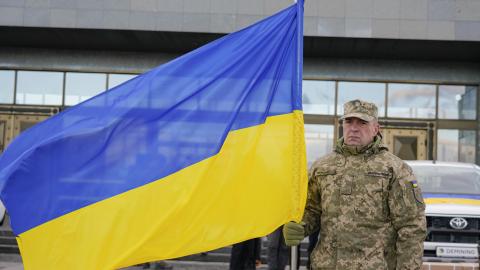Below Senior Fellow Can Kasapoğlu offers a military situation report about the war in Ukraine.
Executive Summary
• Ukrainian and North Korean forces clashed in the Russian region of Kursk, marking the first combat between the two nations. Intelligence estimates suggest that Pyongyang has dispatched three generals and a 10,000-strong contingent of troops for combat operations.
• Ukraine struck two Russian frigates in the Caspian Sea. This is the first such strike in this crucial waterway through which Russia and Iran conduct weapons transfers.
• Russia’s use of Iranian Shahed drones increased tenfold from 2023 to 2024; last month, Russia launched more than 2,000 of these loitering munitions at Ukrainian population centers.
• The Russian military gained territory in Ukraine’s east, while the Ukrainian military has been trying to return deserters and absent soldiers to its ranks.
1. Ukraine’s First Encounter with North Korean Troops Marks a Pivotal Moment
In the Russian region of Kursk, North Korean combat formations reportedly exchanged fire with Ukrainian servicemen for the first time since Pyongyang deployed its forces to Russia.
The limited availability of open-source intelligence makes it difficult to assess this skirmish in detail. But press sources have noted that North Korea’s troops were equipped with assault rifles, 60mm mortars, rocket-propelled grenades (RPGs), sniper weaponry, night-vision equipment, and hand grenades. This reinforces previous assessments that special forces light infantry units are the backbone of the forward-deployed North Korean presence for now.
According to Ukrainian defense intelligence sources, three North Korean generals and up to 500 officers have already made it to Russia to oversee the units deployed there. The US Defense Intelligence Agency has concluded that many of these brigades are from Pyongyang’s 11th Corps special forces unit. This corps is considered a strategic force and is trained to open a second front in a conventional conflict or attack an enemy’s rear area.
The United States Department of Defense reported that Pyongyang has already fielded around 10,000 troops in Kursk for combat operations. South Korean intelligence services foresaw a total contingent of around 12,000 arriving in the region. But force-generation patterns suggest that North Korea’s deployment there may eventually be even more substantial than this estimate.
Two questions loom large at this juncture. First, will the North Korean troops’ mandate extend beyond Kursk to fighting in occupied Ukraine? Second, will Pyongyang reinforce its initial deployments with additional troops? Our forecast suggests the answer to both questions is yes, underscoring the potential for a significant escalation of the conflict.
2. Ukraine Conducts Strikes in Geopolitically Crucial Caspian Sea
Ukraine’s Main Directorate of Intelligence (GUR) reportedly struck two Gepard-class frigates in the Caspian Sea, showcasing the increasing reach and strength of Ukraine’s drone warfare capabilities. Equipped with Kalibr naval cruise missiles, these frigates play a vital role in the Russian Navy’s long-range strike deterrent. Russia’s Caspian flotilla has previously launched Kalibr missiles to hammer Ukrainian population centers.
The Caspian Sea has also become important for strategic transactions between the Russian military and its Iranian partners. The extension of Ukraine’s long-range drone threat to the Caspian marks a meaningful shift in the war—particularly should Kyiv repeat this success and continue to pressure Russian naval warfare capabilities in the basin.
3. Shahed Drone Strikes on Ukraine Have Increased Tenfold from 2023 to 2024
Last week Ukrainian President Volodymyr Zelenskyy sounded the alarm about the worrying rise in Shahed drone salvos, stating that Russian forces have employed the loitering munitions 10 times as often as they did in 2023. According to the Ukrainian high command, the most recent three-month data-collection period featured 4,300 Shahed launches. October was particularly grim, as it saw over 2,000 of the drones rain down on Ukrainian population centers. Russia used 790 Shahed drones in August of this year, and 1,300 in September.
This boost in attacks carries implications well beyond Ukraine. Iranian drones are being produced at astronomical levels. When Iran and Russia initially launched their joint drone production plant in the Russian region of Tatarstan in 2023, initial estimates pegged its annual production rate at around 2,500 drones. By exploiting the indigenous Tatar population—and even using child labor—the Kremlin believes it can produce 6,000 Shaheds annually by 2025. Worryingly, current drone warfare trends in Ukraine suggest that Russia and Iran may have already met this production goal.
Previous editions of this report have observed that the Islamic Republic and the Kremlin are now capable of producing massive amounts of low-cost loitering munitions on the doorstep of the North Atlantic Treaty Organization (NATO). The two allies can now sustain a high operational tempo of more than 2,000 drones per month. Even if Ukraine intercepts 90 percent of these munitions, it would be allowing 200 hits a month on civilian and military targets. With evolutions including thermobaric and high-explosive-incendiary warhead configurations, Shahed drones have become more destructive than ever.
4. Battlefield Assessment
Russian forces have managed to gain territory on multiple fronts. Facing problematic manpower disadvantages, Ukraine has issued a social media summons to personnel who have deserted or are considered absent without leave (AWOL). Ukraine is also bracing for another mobilization.
Last week Russia captured the Ukrainian village of Kurakhiva, further boosting its push into Kurakhove. Kurakhove, situated between the Vovcha River and the N-15 Highway, lies south of the strategically important city of Pokrovsk.
Another critical flashpoint on the eastern front is Illinka, where the Ukrainian 79th Air Assault Brigade has been trying to hold the line against Russia’s formidable 20th Motor Rifle Division. Available writings suggest that Russian formations have a favorable five-to-one force-on-force ratio here.
The Russian offensive has also advanced on other fronts. In Siversk, heightened combat activity and growing material losses have characterized the fighting. In southern Ukraine, Russia has intensified its tactical efforts without tangible success.
Finally, in the Russian region of Kursk, the powerful Ukrainian 47th Mechanized Brigade’s Abrams main battle tanks and Bradley infantry fighting vehicles have been engaging Russian heavy armor. North Korean troops face considerable odds as they enter the fray.
















